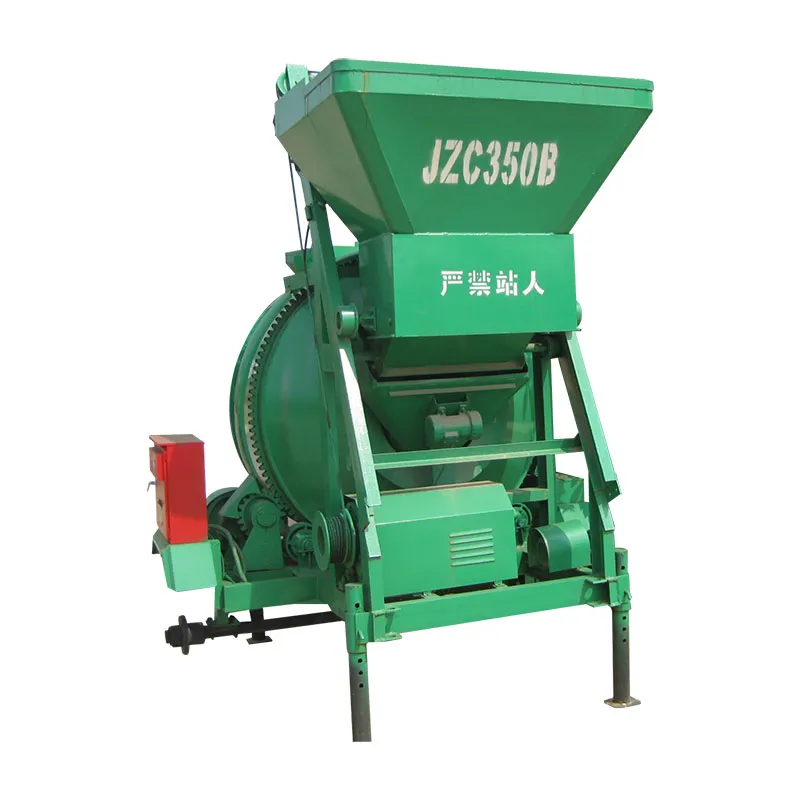Methods of Operating a Concrete Mixer
2024-10-12
A concrete mixer is a machine used to mix cement, water, and aggregates (such as sand or gravel) to form concrete. The primary purpose of the mixer is to create a uniform mixture with consistent properties, essential for building and construction projects. Below are the main methods of operating a concrete mixer:

1. Batch Mixing Method
The batch mixing method is the most common way of using a concrete mixer. It involves adding the required ingredients in predetermined proportions, mixing them for a certain time, and then discharging the mixed concrete. This method is typically used for smaller to medium-sized projects and is divided into several steps:
1. Loading the Materials:
- Load the mixer with the correct proportion of cement, sand, gravel, and water. Depending on the type of mixer, the loading may be done manually or through an automatic feeding system.
2. Mixing:
- The mixer begins rotating or tumbling, blending the materials together to form a homogeneous mix. The mixing time usually ranges from 2 to 5 minutes depending on the size and type of the mixer and the consistency required.
3. Discharging:
- Once mixed, the concrete is discharged from the mixer drum into wheelbarrows, buckets, or directly onto the site, depending on the project needs. The mixer can be tilted or the drum can be reversed to release the concrete.
2. Continuous Mixing Method
The continuous mixing method is used in large-scale construction projects that require a steady, uninterrupted supply of concrete. Unlike the batch method, in continuous mixing, ingredients are fed into the mixer continuously, and the mixed concrete is continuously discharged. This method is suitable for large projects like roadways or large slabs.
1. Feeding Materials:
- Ingredients (cement, aggregates, and water) are continuously added to the mixer through conveyors or hoppers at a steady rate.
2. Mixing:
- As materials are continuously fed, the mixer continuously churns them, ensuring that fresh concrete is produced without pauses.
3. Discharge:
- The concrete is discharged at a constant rate, ideal for projects where a large volume of concrete is required without interruption.
3. Hand Mixing Method
For small projects, where only a limited amount of concrete is needed, manual mixing may be employed. Although less efficient and labor-intensive, it is sometimes used in situations where machinery is not available or for very small quantities of concrete.
1. Loading the Materials:
- The ingredients (cement, sand, gravel, and water) are loaded onto a flat surface or in a mixing trough in the correct proportions.
2. Mixing:
- The materials are mixed manually using shovels or hoes until a uniform mixture is achieved. This method requires a lot of effort and time but is used for small tasks.
3. Discharge:
- After mixing, the concrete is moved to the point of use, such as filling molds or laying small patches.
4. Ready-Mix Method (Truck-Mounted Mixer)
In large projects, ready-mix concrete is often prepared in batching plants and transported to the site in truck-mounted drum mixers. The concrete is mixed while the truck is en route to the construction site, and it continues to rotate slowly to keep the concrete in a uniform consistency.
1. Loading at the Plant:
- Concrete is prepared and loaded into the truck at a centralized batching plant.
2. Mixing During Transit:
- The truck’s drum rotates at a slow speed while driving to the construction site, ensuring the concrete remains mixed and fresh.
3. Discharge at the Site:
- Upon arrival, the drum can rotate at a faster speed to thoroughly mix the contents, after which the concrete is discharged via chutes or pumps.
Types of Concrete Mixers
- Drum Mixers: These are the most common types used, where materials are rotated in a drum. Examples include:
- Tilting Drum Mixers: Used for small batches; easy to discharge.
- Non-Tilting Drum Mixers: The drum doesn’t tilt; discharge is via an opening.
- Reversing Drum Mixers: The drum rotates in one direction for mixing and reverses for discharging.
- Pan Mixers: Feature a stationary drum with rotating blades. Often used for precast concrete and high-performance mixes.
- Continuous Mixers: As mentioned earlier, these are used for large-scale projects requiring continuous production.
Conclusion
The method of operating a concrete mixer depends on the type of mixer and the scale of the project. Batch mixing is the most common for general construction, while continuous mixing is preferred for larger applications. Ready-mix concrete offers convenience and is ideal for big projects, whereas manual mixing is only suitable for small-scale tasks. Understanding these methods ensures better concrete quality and project efficiency.


